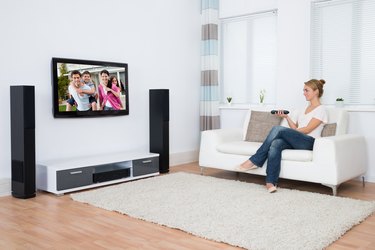
LCD TV screens are an advancement from older tube monitors that use far less power, and the displays are easier to manipulate because of the flexibility of the crystals. If you're seeing vertical lines over parts of your screen that prevent you from seeing the image, this is most often a result of faulty internal hardware, loose cables or a broken screen.
Potential Hardware Causes
Video of the Day
For an LCD to work properly, the red, green and blue colors need to know where to be positioned on the screen to form a picture. Every spot on an LCD panel has a horizontal and vertical address for the three colors; if there are a number of vertical lines on your screen, the horizontal address isn't working correctly or the columns aren't responding accordingly. This could be a sign of a loose or disconnected ribbon that's responsible for moving data from the main board to the LCD panel. If a ribbon is loose, it's most likely the one connecting the board to the front panel.
Video of the Day
T-Con Board
The t-con board in an LCD TV acts as a bridge between the LCD panel itself and the main board. If there's anything wrong with the t-con board, it could produce a faulty display. Failing t-con boards are a common cause of this problem in LCD TVs, so if you're comfortable working on your TV, replacement parts for your TV's model can often be found online. The board itself is most often found in the top center of the back of the TV, often covered with an aluminum panel. Replacing this part can be a challenge, so if you don't feel comfortable working on your TV, consult your TV's manufacturer for support and possible repairs.
Loose Cable/Ribbon
Loose cables and ribbons connecting the LCD panel to the main board can cause a disruption in the picture. The main board of an LCD TV is most often found inside the back of the TV, at the top in the center. The main board houses the t-con board and the connection cables between itself and the LCD panel, so if any of these parts are loose or faulty, it can cause distortions on parts or all of your screen. Make sure all of the cables are plugged in securely; you can also try disconnecting and reconnecting them to make sure they're reading correctly.
Faulty LCD
Any damage to the LCD panel itself can cause distortions. If this is the case, then replacing hardware won't help, and the screen itself will have to be replaced. If there's any damage, it might have been faulty from the beginning or may have been caused if the TV was dropped or hit by another object. Replacing the screen is easiest to do by letting the TV's manufacturer replace or repair it, but this can usually only be done if your TV is still under warranty. In many cases it will be more cost effective to simply buy a new TV altogether, since replacement screens can be very expensive.
Considerations
If you don't feel comfortable working on your TV to replace parts or even check inside the frame, your TV's manufacturer may provide repairs and/or replacements if your TV is still under warranty. Unless you're experienced with working on similar devices, let a qualified repairmen look at it. Even if you're comfortable taking it apart, make sure that doing so won't void any warranties.